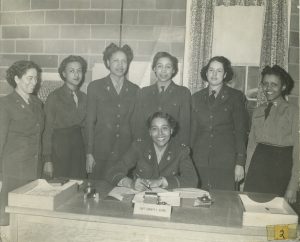 As a result of the influence of Army Chief of Staff General George C. Marshall, women of color joined the Women’s Army Corps’ 6888th Central Postal Battalion. During World War II, 850 African-American women served overseas, in Birmingham, England, to sort and deliver backed-up mail to millions of soldiers in Europe.
As a result of the influence of Army Chief of Staff General George C. Marshall, women of color joined the Women’s Army Corps’ 6888th Central Postal Battalion. During World War II, 850 African-American women served overseas, in Birmingham, England, to sort and deliver backed-up mail to millions of soldiers in Europe.
Army Major Charity Adams, the first African-American woman to become an Army officer, was in charge. Adams had been working on a graduate degree at Ohio State University when she joined the Women’s Army Auxiliary Corp. She recalled an early incident that upset her. “What made things worse was that even after the ‘colored girls’ had been pushed to the side, all the rest of the women were called by name to join a group to be led to their quarters. Why could not the ‘colored girls’ be called by name to go to their quarters rather than be isolated by race?”
 Arriving overseas, she and her unit would not be pushed aside like women of color back home. Major Adams asked her unit not to settle for segregated quarters and urged them to socialize with the white soldiers and citizens to create an atmosphere of comradeship among enlisted personnel.
Arriving overseas, she and her unit would not be pushed aside like women of color back home. Major Adams asked her unit not to settle for segregated quarters and urged them to socialize with the white soldiers and citizens to create an atmosphere of comradeship among enlisted personnel.
Adams did not accept racism easily. In one incident, a general threatened to assign a white first lieutenant to “show [her] how to run this unit,” to which she replied, “Over my dead body, sir.”
By the end of World War II, she was the highest ranking African-American woman in the military. Later she became a dean at Tennessee Agricultural & Industrial State College (renamed Tennessee State University in 1968) and Georgia State Univ. She remarked, “When I talk to students, they say, ‘How did it feel to know you were making history?’ But you don’t know you’re making history when it’s happening. I just wanted to do my job.”
